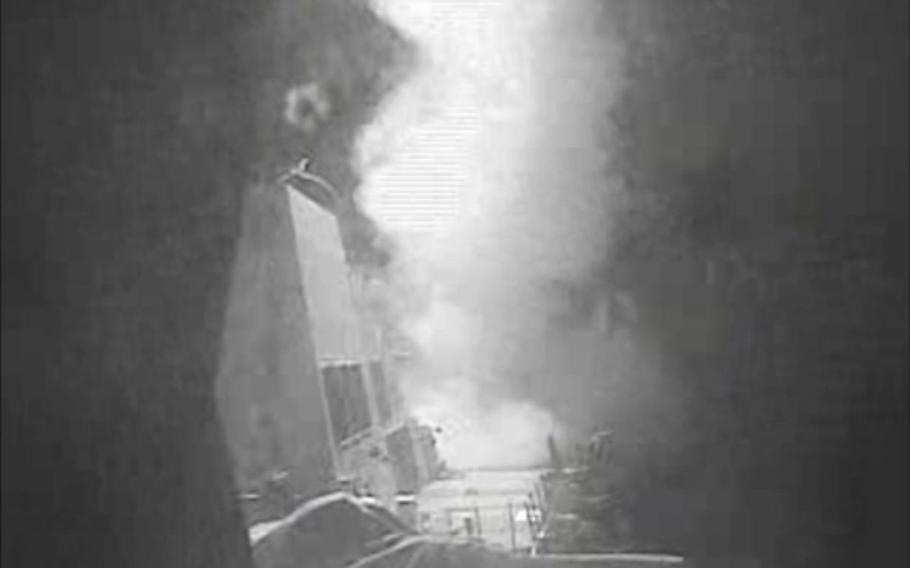
A video screen grab shows a missile launch from the USS Nitze on Oct. 13, 2016, in the Red Sea off the coast of Yemen. ()
Attacks on U.S. Navy ships in the Red Sea have cast the spotlight on Yemen, an impoverished country engulfed in a bewilderingly complex war that is drawing in the United States.
Here are the stakes in Yemen and why the conflict there is important to U.S. interests in the Middle East and the global struggle against Islamist terrorism.
Question: Who’s shooting at us and why?
Answer: The missiles that were fired at the destroyer USS Mason during the past week came from territory controlled by rebels known as the Houthis (WHO-thees), Iranian-backed Shiite tribesmen from northern Yemen. The Houthis, whose name comes from their founder Hussein Badreddin al-Houthi, seized the capital of Sanaa in September 2014 and overthrew the U.S. and Saudi-backed government. In response, Saudi Arabia and its Gulf allies, backed by the United States, launched an air and ground campaign against the Houthis in March 2015. Because the U.S. supports the Saudis, the Houthis consider Americans a party to that conflict, which has killed about 10,000 people, including many civilians.
Q: Who are the Houthis?
A: The Houthis, who call themselves Ansar Allah or “Supporters of God,” became active in the 1990s to demand social and political reform. In 2004 the Houthis launched an armed insurgency that gained momentum seven years later during the Arab Spring uprising against longtime President Ali Abdullah Saleh. The U.S. and Saudi Arabia feared the growing instability in Yemen would open the door to Islamist extremism. Under pressure from Saudi Arabia and the U.S., Saleh stepped down in favor of his vice president, Abed Rabbo Mansour Hadi. However, Hadi was unable to consolidate power and in September 2014, the Houthis swept into Sanaa, forcing his government to resign. The Saudis saw the Houthis as Iranian agents threatening their southern border at a time when Iraq on the northern frontier was falling deeper into Iran’s orbit.
Q: Why is Yemen so unstable?
A: Yemen, the homeland of Osama bin Laden’s family, is the poorest country on the Arabian Peninsula and has been wracked by political turmoil for most of the last 50 years. During the Cold War, the country broke in two, with South Yemen becoming a Soviet client state and the North struggling for international support. In 1990, as the Cold War was fading, the two countries reunited, a move that failed to bring lasting stability due to political, tribal and religious rivalry that opened the door to Islamist extremism.
Q: Why does the U.S. care what happens in Yemen?
A: Part of the reason is location. Yemen sits along the southwestern corner of the Arabian Peninsula along the Red Sea, a strategic route to the Persian Gulf. U.S. warships traveling to and from the Gulf transit the Red Sea, whose southern entrance is the Bab el-Mandeb Strait -- only 25 miles wide at its narrowest point. The other part is Yemen’s role in the fight against global terrorism. In January 2009, the Saudi and Yemeni branches of al-Qaida merged to form al-Qaida in the Arabian Peninsula, or AQAP. U.S. intelligence at the time identified AQAP as the terror movement’s most dangerous branch. Among other things, the Yemen al-Qaida branch was responsible for the failed attempt by the “underwear bomber” to blow up a U.S. airliner approaching Detroit on Christmas Day 2009. U.S.-born cleric Anwar al-Awlaki used Yemen as a base where he broadcast online sermons recruiting young Muslims in the west. Al-Awlaki was killed by a U.S. missile strike in September 2011 but U.S. intelligence believes his online sermons remain a valuable recruiting tool. The Houthis say they oppose al-Qaida but are considered a threat to U.S. and Saudi interests because of their ties to Iran.
Q: In addition to the al-Qaida threat, has Yemen morphed into a U.S.-Iranian proxy war?
A: The Houthis have long denied they are Iranian proxies although Saudi Arabia and the U.S. believe they are. Media reports say Iranian flights to Sanaa have increased since the city fell to the Houthis. Their slogan “Death to America, death to Israel, damnation to the Jews and victory for Islam” lines them up in an anti-Western camp that includes Hezbollah in Lebanon and pro-Iranian militias in Syria and Iraq.